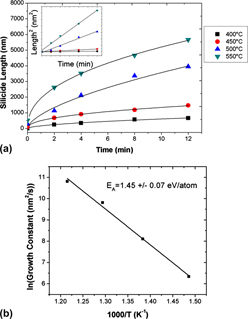Crossref Citations
This article has been cited by the following publications. This list is generated based on data provided by
Crossref.
Dellas, N. S.
Schuh, C. J.
and
Mohney, S. E.
2012.
Silicide formation in contacts to Si nanowires.
Journal of Materials Science,
Vol. 47,
Issue. 17,
p.
6189.
Tang, Wei
Picraux, S. Tom
Huang, Jian Yu
Gusak, Andriy M.
Tu, King-Ning
and
Dayeh, Shadi A.
2013.
Nucleation and Atomic Layer Reaction in Nickel Silicide for Defect-Engineered Si Nanochannels.
Nano Letters,
Vol. 13,
Issue. 6,
p.
2748.
Lu, Jun
Gao, Xindong
Zhang, Shi-Li
and
Hultman, Lars
2013.
Crystallization of NiSix in a Body-Centered Cubic Structure during Solid-State Reaction between an Ultrathin Ni Film and Si(001) Substrate at 150–350 °C.
Crystal Growth & Design,
Vol. 13,
Issue. 5,
p.
1801.
Beregovsky, M.
Katsman, A.
Hajaj, E.M.
and
Yaish, Y.E.
2013.
Diffusion formation of nickel silicide contacts in SiNWs.
Solid-State Electronics,
Vol. 80,
Issue. ,
p.
110.
Katsman, Alex
Beregovsky, Michael
and
Yaish, Yuval E.
2013.
Evolution of nickel silicide intrusions in silicon nanowires during thermal cycling.
Journal of Applied Physics,
Vol. 113,
Issue. 8,
Tang, Wei
Nguyen, Binh-Minh
Chen, Renjie
and
Dayeh, Shadi A
2014.
Solid-state reaction of nickel silicide and germanide contacts to semiconductor nanochannels.
Semiconductor Science and Technology,
Vol. 29,
Issue. 5,
p.
054004.
Katsman, Alex
Beregovsky, Michael
and
Yaish, Yuval Eliyahu
2014.
Formation and Evolution of Nickel Silicide in Silicon Nanowires.
IEEE Transactions on Electron Devices,
Vol. 61,
Issue. 10,
p.
3363.
Peter, Antony Premkumar
Meersschaut, Johan
Richard, Olivier
Moussa, Alain
Steenbergen, Johnny
Schaekers, Marc
Tőkei, Zsolt
Van Elshocht, Sven
and
Adelmann, Christoph
2015.
Phase Formation and Morphology of Nickel Silicide Thin Films Synthesized by Catalyzed Chemical Vapor Reaction of Nickel with Silane.
Chemistry of Materials,
Vol. 27,
Issue. 1,
p.
245.
Chen, Renjie
and
Dayeh, Shadi A.
2015.
Size and Orientation Effects on the Kinetics and Structure of Nickelide Contacts to InGaAs Fin Structures.
Nano Letters,
Vol. 15,
Issue. 6,
p.
3770.
Peter, Antony Premkumar
Witters, Thomas
Dutta, Shibesh
Hikavvy, Andriy
Vaesen, Inge
Van Elshocht, Sven
and
Schaekers, Marc
2016.
Phase analysis and thermal stability of thin films synthesized via solid state reaction of Ni with Si1−xGex substrate.
Microelectronic Engineering,
Vol. 149,
Issue. ,
p.
46.
Khan, Muhammad Bilal
Deb, Dipjyoti
Kerbusch, Jochen
Fuchs, Florian
Löffler, Markus
Banerjee, Sayanti
Mühle, Uwe
Weber, Walter M.
Gemming, Sibylle
Schuster, Jörg
Erbe, Artur
and
Georgiev, Yordan M.
2019.
Towards Reconfigurable Electronics: Silicidation of Top-Down Fabricated Silicon Nanowires.
Applied Sciences,
Vol. 9,
Issue. 17,
p.
3462.
Chen, Renjie
and
Dayeh, Shadi A.
2019.
Nanowire Electronics.
p.
111.
Khan, Muhammad Bilal
Prucnal, Slawomir
Ghosh, Sayantan
Deb, Dipjyoti
Hübner, René
Pohl, Darius
Rebohle, Lars
Mikolajick, Thomas
Erbe, Artur
and
Georgiev, Yordan M.
2021.
Controlled Silicidation of Silicon Nanowires Using Flash Lamp Annealing.
Langmuir,
Vol. 37,
Issue. 49,
p.
14284.
Simon, Maik
Mizuta, Ryo
Fan, Ye
Tahn, Alexander
Pohl, Darius
Trommer, Jens
Hofmann, Stephan
Mikolajick, Thomas
and
Weber, Walter M.
2021.
Lateral Extensions to Nanowires for Controlling Nickel Silicidation Kinetics: Improving Contact Uniformity of Nanoelectronic Devices.
ACS Applied Nano Materials,
Vol. 4,
Issue. 5,
p.
4371.
Shu, Gangqiang
Hu, Chunfeng
Teng, Tong
and
Qu, Xin-Ping
2021.
Linewidth related resistivities and growth behavior of nickel silicide nanowires by solid state reaction between Ni and electron-beam lithography prepared Si nanowires.
Thin Solid Films,
Vol. 724,
Issue. ,
p.
138612.
Gu, Sijie
Shu, Gangqiang
Hu, Chun-Feng
and
Qu, Xin-Ping
2023.
Comparison between the solid state reaction of ultrathin Ni and Ni/Ti with Si nanowire on silicon-on-insulator.
Thin Solid Films,
Vol. 781,
Issue. ,
p.
139998.
Cai, Jun
Zhang, Huairuo
Tan, Yuanqiu
Sun, Zheng
Wu, Peng
Tripathi, Rahul
Krylyuk, Sergiy
Suhy, Caleb
Kong, Jing
Davydov, Albert V.
Chen, Zhihong
and
Appenzeller, Joerg
2024.
On‐Chip Synthesis of Quasi‐2D Semimetals from Multi‐Layer Chalcogenides.
Advanced Materials,
Vol. 36,
Issue. 46,



